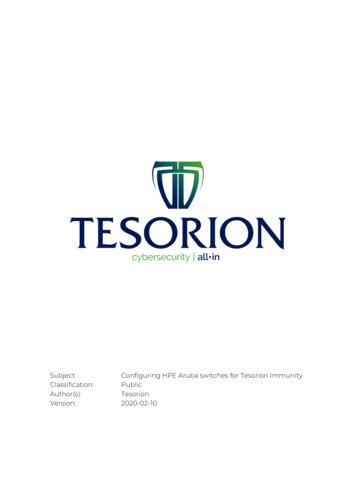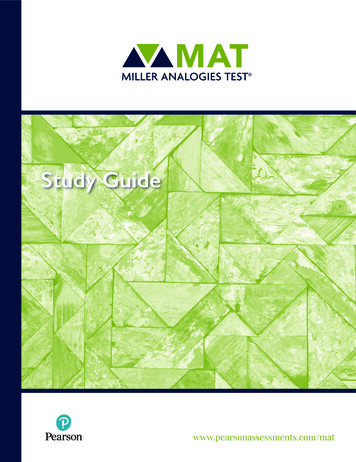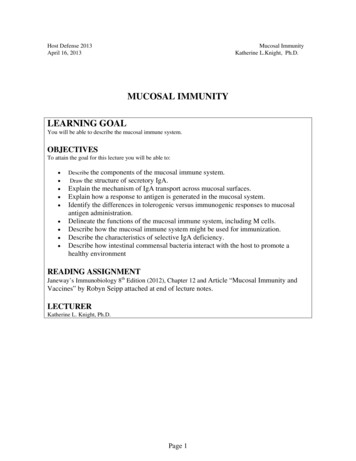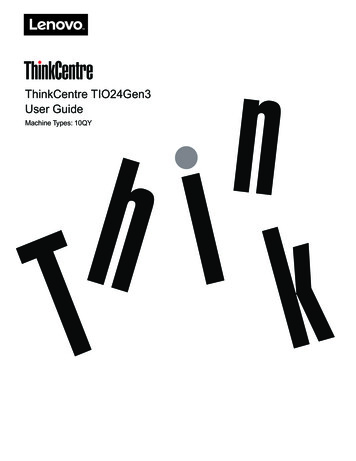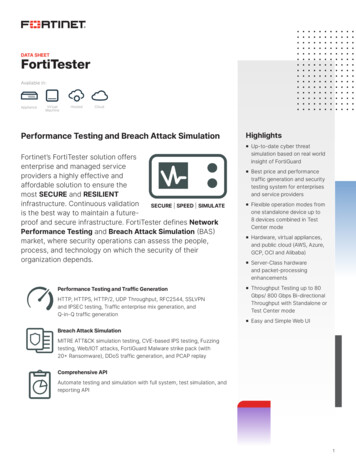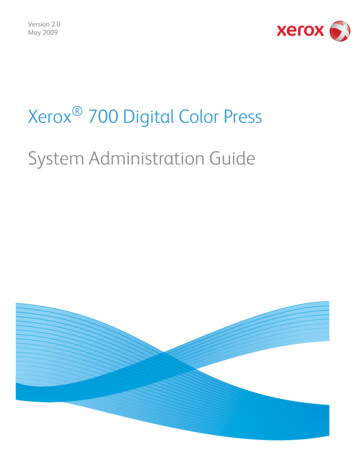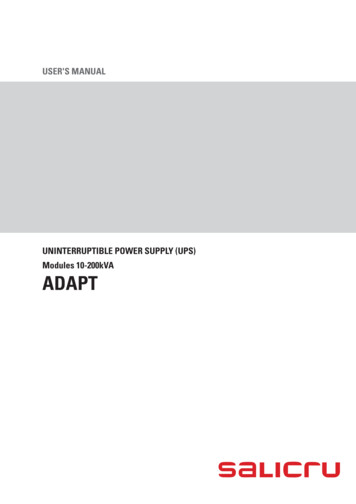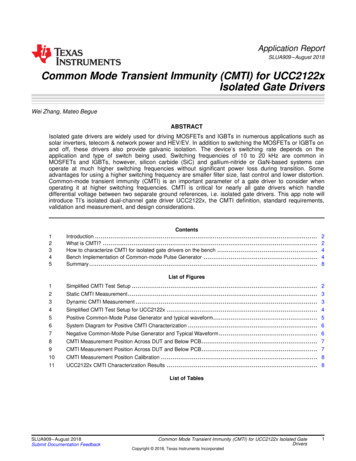
Transcription
Application ReportSLUA909 – August 2018Common Mode Transient Immunity (CMTI) for UCC2122xIsolated Gate DriversWei Zhang, Mateo BegueABSTRACTIsolated gate drivers are widely used for driving MOSFETs and IGBTs in numerous applications such assolar inverters, telecom & network power and HEV/EV. In addition to switching the MOSFETs or IGBTs onand off, these drivers also provide galvanic isolation. The device’s switching rate depends on theapplication and type of switch being used. Switching frequencies of 10 to 20 kHz are common inMOSFETs and IGBTs, however, silicon carbide (SiC) and gallium-nitride or GaN-based systems canoperate at much higher switching frequencies without significant power loss during transition. Someadvantages for using a higher switching frequency are smaller filter size, fast control and lower distortion.Common-mode transient immunity (CMTI) is an important parameter of a gate driver to consider whenoperating it at higher switching frequencies. CMTI is critical for nearly all gate drivers which handledifferential voltage between two separate ground references, i.e. isolated gate drivers. This app note willintroduce TI’s isolated dual-channel gate driver UCC2122x, the CMTI definition, standard requirements,validation and measurement, and design considerations.12345ContentsIntroduction .What is CMTI? .How to characterize CMTI for isolated gate drivers on the bench .Bench Implementation of Common-mode Pulse Generator .Summary .22448List of Figures1Simplified CMTI Test Setup . 22Static CMTI Measurement . 33Dynamic CMTI Measurement . 34Simplified CMTI Test Setup for UCC2122x . 45Positive Common-Mode Pulse Generator and typical waveform. 56System Diagram for Positive CMTI Characterization . 67Negative Common-Mode Pulse Generator and Typical Waveform . 68CMTI Measurement Position Across DUT and Below PCB . 79CMTI Measurement Position Across DUT and Below PCB . 710CMTI Measurement Position Calibration . 811UCC2122x CMTI Characterization Results.8List of TablesSLUA909 – August 2018Submit Documentation FeedbackCommon Mode Transient Immunity (CMTI) for UCC2122x Isolated GateDriversCopyright 2018, Texas Instruments Incorporated1
Introductionwww.ti.comTrademarksAll trademarks are the property of their respective owners.1IntroductionWith the increasing progress and adoption of new generation power semiconductor devices, such as SiCand GaN, customer end equipment and applications are requiring higher switching frequencies – withmore than 2X the dv/dt and over 5X the di/dt during turn on/turn off transients compared to conventionalMOSFETs and IGBTs. Common mode transient immunity, known as CMTI and measured in dv/dt (unit:kV/µs or V/ns), is a critical specification that correlates to gate driver robustness for all isolated gatedrivers which handle differential voltage between two separate ground references. This paper will start byexplaining these challenges with bench waveform measurement comparison, and then, discussingisolated gate drivers and identifying the benefits by addressing key specifications with the related noiseimmunity. Finally, the dv/dt (CMTI) and di/dt for isolated gate drivers will be summarized with issuedefinition, standard requirements, bench characterizations and system design solutions using TI’s isolatedgate driver family.2What is CMTI?Common mode transient immunity (CMTI) is defined as the maximum tolerable rate of rise or fall of thecommon mode voltage applied between two isolated circuits. The unit is normally in kV/us or V/ns. HighCMTI means that the two isolated circuits, both transmitter side and receiver side, function well within thedatasheet specifications without error when striking the insulation barrier with very high rise (positive) slewrate, or high fall (negative) slew rate. A simplified CMTI test setup and the typical common-mode pulsewaveform are shown in Figure 1. The IN and OUT signal in the simplified block diagram should alwaysfollow the appropriate logic as the datasheet truth-table specified when the VCM pulse applies on theinsulation barrier. For CMTI testing, the VCM peak voltage should not exceed the allowed maximum peaktransient voltage rating between the two isolated circuits. VDE 0884-11 recommends measuring the slewrate of common-mode pulse calculated from 10% to 90% of the final common-mode pulse ( VCM ). Forisolated gate drivers with less than 50V/ns, this 10%/90% suggestion is a rule of thumb since it is lessdependent on the test setup parasitics. For example, a 1000V VCM peak voltage takes 50ns to rampup/down assuming there is a linear 20V/ns common-mode pulse slew rate, and around 20ns for a typical400V bus system. However, for isolated gate drivers with over 100V/ns, this 10%/90% measurementguide is not accurate enough and may lead to significant inaccuracy due to the dependency of all thecircuit parasitics. For instance, a 200V/ns common-mode slew rate only takes 5ns for a 1000V VCM peakvoltage, and only 2ns for a 400V VCM peak voltage where the parasitics will come into the picture. Thepopular influences include MOSFET nonlinear capacitances, PCB trace inductances, parasitic couplingcapacitance of isolated power supply, the quadrature error of digital oscilloscope and the inputcapacitance of the high voltage probes.Figure 1. Simplified CMTI Test Setup2Common Mode Transient Immunity (CMTI) for UCC2122x Isolated GateDriversCopyright 2018, Texas Instruments IncorporatedSLUA909 – August 2018Submit Documentation Feedback
What is CMTI?www.ti.comStatic CMTI is defining a testing condition while the input is tied to either logic high or logic low, andmonitors the output state when CMT strike happens. The output should stay in the specified high or lowstate within the CMTI specifications over the variation of process, voltage and temperature. Figure 2shows an example of static CMTI measurement, including CMH and CML. For digital isolators whichprimarily concern the signal integrity, the output should remain at the specified logic-high level or logic-lowlevel. For isolated gate driver applications where the output voltage ties to the power semiconductors,such as MOSFET or GaN, VOH(min) and VOL(max) are typically defined as 80% and 20% of the outputVDD power supply. In this case, the power transistor should remain off or on during the common-modepulse transient.INOUTINOUTVOH(min)VOL(max)CMTCMTStatic CMTI - CMHStatic CMTI - CMLFigure 2. Static CMTI MeasurementWhile the dynamic CMTI is the maximum slew rate of VCM with switching of the input, either from high tolow or low to high, coincident or near to the common mode transient pulse. The criteria are similar to thestatic CMTI, which means the output should stay in the correct state. Some fault scenarios may includemissing pulse, excessive propagation delay, high or low error or output latch, shown in Figure 3. UL andVDE 0884-11 don’t specifically discuss the measurement procedure for dynamic CMTI, which is currentlyan optional specification for digital isolators. However, a customer end power electronics system may testdynamic CMTI of an isolated gate driver by driving a half-bridge for their specified power transistor andthen checking the system operation for the possible faults illustrated in .Figure 3. Dynamic CMTI MeasurementSLUA909 – August 2018Submit Documentation FeedbackCommon Mode Transient Immunity (CMTI) for UCC2122x Isolated GateDriversCopyright 2018, Texas Instruments Incorporated3
How to characterize CMTI for isolated gate drivers on the bench3www.ti.comHow to characterize CMTI for isolated gate drivers on the benchFigure 4 shows a simplified circuit diagram of CMTI characterization for UCC2122x. One way to monitorthe output signal in a precise and simple way with a high frequency passive probe is to apply thecommon-mode pulse in the transmitter side with ground reference in the receiver side, shown as the VSSin green lines in Figure 4. The transmitter side bias is powered from a standalone 28V battery and aprogrammable LDO voltage adjuster, which is designed to cover the entire VCCI operating range. A highvoltage 1GHz passive probe is used to measure the dv/dt across the two ground references ofUCC2122x, GND and VSS. Another way is to apply the common-mode pulse in the receiver side withground reference in the transmitter side with battery power for VDDA/B. The major challenge of thesecond solution is that the output signals are floating, which makes it difficult to precisely monitor with ahigh bandwidth passive probe. High voltage differential probes can be used to measure the output signalin a relatively low bandwidth; however, it would be very difficult to capture the high frequency glitch orlogic error.Figure 4. Simplified CMTI Test Setup for UCC2122x4Bench Implementation of Common-mode Pulse GeneratorCommon-mode pulse generators can be implemented in a variety of ways, for example, with an ESDsurge generator. However, the common-mode pulse from different setups may not emulate the switchingtransient that happens in a power electronics system, which is not a perfect textbook waveform as shownin Figure 1. The parasitic inductance and capacitance will introduce fast overshoot, undershoot and highfrequency oscillations. Figure 5 shows a positive pulse generator using a boost converter. When theMOSFET is ON, input voltage VChg charges the inductor and builds up the current (1); when theMOSFET is OFF, the inductor current, IL, charges and discharges the output capacitance of the MOSFETand diode (2), COSS and CD. Thus, a rising voltage pulse, VCM, is generated on the switch node. Theoutput voltage of the Boost converter is used to set the VCM . Given that time is constant and there is afixed inductance (3), the dv/dt of VCM is proportional to the input voltage (VChg) (4). Considering theparasitics, a typical experiment common-mode pulse can be found in Figure 5. This waveform is a closematch of a practical switching waveform in a power electronics system and is programmable by adjustinga single parameter, VChg. Customers can also add external parasitics, or even replace the powertransistor, to adjust the over-/under-shoot.4Common Mode Transient Immunity (CMTI) for UCC2122x Isolated GateDriversCopyright 2018, Texas Instruments IncorporatedSLUA909 – August 2018Submit Documentation Feedback
Bench Implementation of Common-mode Pulse Generatorwww.ti.comFigure 5. Positive Common-Mode Pulse Generator and typical waveform . 8%DC 610.B(1) .@8%/ %155 %&@P8%DC 610@8%/ @P.B :%155 %& ;@8%/ß 8%DC 6KJ ,@P(2)(3).B %KJOP .(4)Combining Figure 4 and Figure 5 together, Figure 6 shows a complete positive CMTI test diagram with theswitch node tied to the ground reference of the transmitter side. This booster converter can be used as abuilding block to strike the receiver side if necessary. Following a similar methodology, a buck-boostconverter can be used for generating the negative common-mode pulse, shown in Figure 7. The majorconsideration of this negative pulse generator is that a floating isolated VChg power supply is required, aswell as the floating high side MOSFET drive. Here are a few hardware design considerations: Select MOSFET, SiC-MOSFET, or GaN with small COSS SiC Diode with small CD Air core inductor with small parasitic winding capacitance Minimization of parasitic capacitive coupling between the two separate ground Use floating battery to drive the high side switch for negative CMTI common-pulse generator instead ofisolated power supplySLUA909 – August 2018Submit Documentation FeedbackCommon Mode Transient Immunity (CMTI) for UCC2122x Isolated GateDriversCopyright 2018, Texas Instruments Incorporated5
Bench Implementation of Common-mode Pulse Generatorwww.ti.comFigure 6. System Diagram for Positive CMTI CharacterizationFigure 7. Negative Common-Mode Pulse Generator and Typical WaveformAnother finding during CMTI characterization regards the measurement position. The ideal location wouldbe right across the DUT, at which position it tells the true measurement results and reflects the true siliconperformance. However, under temperature characterization, thermal stream is covering the DUT, making itnot feasible to probe right on the DUT. To monitor the dv/dt under temperature characterization, anotherclose position is under the mother board, as seen in Figure 8. It is around 1in away from DUT in the finalsetup. Figure 9 also shows one example of CMTI waveforms measured both across DUT and below thePCB at room temperature at the same common-pulse test condition (pink is measured across DUT which6Common Mode Transient Immunity (CMTI) for UCC2122x Isolated GateDriversCopyright 2018, Texas Instruments IncorporatedSLUA909 – August 2018Submit Documentation Feedback
Bench Implementation of Common-mode Pulse Generatorwww.ti.comshows 201V/ns and blue measured below PCB which shows 175V/ns with both probes carefullycalibrated). There is a mismatch of 26V/ns, which is caused by the introduced parasitic inductancebetween DUT and the common-mode pulse generator. Figure 10 summarizes the calibration results forboth positive and negative CMTI with vertical axis as CMTI differences, CMTI CMTIDUT CMTIPCB, andhorizontal axis as the CMTI measured below PCB. The CMTI can be as large as 40V/ns when CMTI isaround 200V/ns.Figure 8. CMTI Measurement Position Across DUT and Below PCBFigure 9. CMTI Measurement Position Across DUT and Below PCBSLUA909 – August 2018Submit Documentation FeedbackCommon Mode Transient Immunity (CMTI) for UCC2122x Isolated GateDriversCopyright 2018, Texas Instruments Incorporated7
Summarywww.ti.comFigure 10. CMTI Measurement Position Calibration5SummaryThrough the discussion of the definition of CMTI, CMTI system impact, bench implementation of commonmode positive and negative pulse generators, the final CMTI bench setup is able to characterizeUCC2122x up to 250V/ns across 40 C 125 C. Figure 11 shows the final test result of CMTIcharacterization. The lowest CMTI happens at low temperature 40 C, and the highest CMTI is around250V/ns at 125 C, which demonstrates the robust operation of UCC2122x on a noisy switchingenvironment.Figure 11. UCC2122x CMTI Characterization Results8Common Mode Transient Immunity (CMTI) for UCC2122x Isolated GateDriversCopyright 2018, Texas Instruments IncorporatedSLUA909 – August 2018Submit Documentation Feedback
IMPORTANT NOTICE FOR TI DESIGN INFORMATION AND RESOURCESTexas Instruments Incorporated (‘TI”) technical, application or other design advice, services or information, including, but not limited to,reference designs and materials relating to evaluation modules, (collectively, “TI Resources”) are intended to assist designers who aredeveloping applications that incorporate TI products; by downloading, accessing or using any particular TI Resource in any way, you(individually or, if you are acting on behalf of a company, your company) agree to use it solely for this purpose and subject to the terms ofthis Notice.TI’s provision of TI Resources does not expand or otherwise alter TI’s applicable published warranties or warranty disclaimers for TIproducts, and no additional obligations or liabilities arise from TI providing such TI Resources. TI reserves the right to make corrections,enhancements, improvements and other changes to its TI Resources.You understand and agree that you remain responsible for using your independent analysis, evaluation and judgment in designing yourapplications and that you have full and exclusive responsibility to assure the safety of your applications and compliance of your applications(and of all TI products used in or for your applications) with all applicable regulations, laws and other applicable requirements. Yourepresent that, with respect to your applications, you have all the necessary expertise to create and implement safeguards that (1)anticipate dangerous consequences of failures, (2) monitor failures and their consequences, and (3) lessen the likelihood of failures thatmight cause harm and take appropriate actions. You agree that prior to using or distributing any applications that include TI products, youwill thoroughly test such applications and the functionality of such TI products as used in such applications. TI has not conducted anytesting other than that specifically described in the published documentation for a particular TI Resource.You are authorized to use, copy and modify any individual TI Resource only in connection with the development of applications that includethe TI product(s) identified in such TI Resource. NO OTHER LICENSE, EXPRESS OR IMPLIED, BY ESTOPPEL OR OTHERWISE TOANY OTHER TI INTELLECTUAL PROPERTY RIGHT, AND NO LICENSE TO ANY TECHNOLOGY OR INTELLECTUAL PROPERTYRIGHT OF TI OR ANY THIRD PARTY IS GRANTED HEREIN, including but not limited to any patent right, copyright, mask work right, orother intellectual property right relating to any combination, machine, or process in which TI products or services are used. Informationregarding or referencing third-party products or services does not constitute a license to use such products or services, or a warranty orendorsement thereof. Use of TI Resources may require a license from a third party under the patents or other intellectual property of thethird party, or a license from TI under the patents or other intellectual property of TI.TI RESOURCES ARE PROVIDED “AS IS” AND WITH ALL FAULTS. TI DISCLAIMS ALL OTHER WARRANTIES ORREPRESENTATIONS, EXPRESS OR IMPLIED, REGARDING TI RESOURCES OR USE THEREOF, INCLUDING BUT NOT LIMITED TOACCURACY OR COMPLETENESS, TITLE, ANY EPIDEMIC FAILURE WARRANTY AND ANY IMPLIED WARRANTIES OFMERCHANTABILITY, FITNESS FOR A PARTICULAR PURPOSE, AND NON-INFRINGEMENT OF ANY THIRD PARTY INTELLECTUALPROPERTY RIGHTS.TI SHALL NOT BE LIABLE FOR AND SHALL NOT DEFEND OR INDEMNIFY YOU AGAINST ANY CLAIM, INCLUDING BUT NOTLIMITED TO ANY INFRINGEMENT CLAIM THAT RELATES TO OR IS BASED ON ANY COMBINATION OF PRODUCTS EVEN IFDESCRIBED IN TI RESOURCES OR OTHERWISE. IN NO EVENT SHALL TI BE LIABLE FOR ANY ACTUAL, DIRECT, SPECIAL,COLLATERAL, INDIRECT, PUNITIVE, INCIDENTAL, CONSEQUENTIAL OR EXEMPLARY DAMAGES IN CONNECTION WITH ORARISING OUT OF TI RESOURCES OR USE THEREOF, AND REGARDLESS OF WHETHER TI HAS BEEN ADVISED OF THEPOSSIBILITY OF SUCH DAMAGES.You agree to fully indemnify TI and its representatives against any damages, costs, losses, and/or liabilities arising out of your noncompliance with the terms and provisions of this Notice.This Notice applies to TI Resources. Additional terms apply to the use and purchase of certain types of materials, TI products and services.These include; without limitation, TI’s standard terms for semiconductor products http://www.ti.com/sc/docs/stdterms.htm), evaluationmodules, and samples (http://www.ti.com/sc/docs/sampterms.htm).Mailing Address: Texas Instruments, Post Office Box 655303, Dallas, Texas 75265Copyright 2018, Texas Instruments Incorporated
A simplified CMTI test setup and the typical common-mode pulse waveform are shown in Figure 1. The IN and OUT signal in the simplified block diagram should always follow the appropriate logic as the datasheet truth-table specified when the VCM pulse applies on the . CMT V OH(min) IN OUT CMT V OL(max) Static CMTI - CM H Static CMTI - CM L www .
